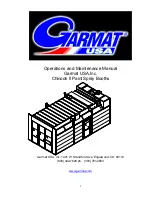
MTS Exceed™ 22 Series Product Information
12
Safety Practices During System Operations
Safety
Recording Changes
Made
In the event that you make any changes to any operating procedures, record all
changes made and the dates when they are made in the manual.
Test
Area Protection
When testing hazardous specimens (such as crisp or fragile materials, or
internally-pressurized materials), use protective shells, such as cages, shields and
special laboratory layout.
Do Not Disable
Safety
Apparatus
Your system may be equipped with active or passive safety apparatus. Do not
disable such apparatus to avoid unexpected system actions.
Using Fuses up to
Specifications
Whenever fuses of the system or power sources are replaced, ensure that a
suitable fuse is used and installed correctly. Fuses thicker or thinner than the
prescribed specifications may lead to overheat of cables and explosion of the
fuse. And either case may cause a fire.
Providing Adequate
Lighting
Ensure adequate lighting, to minimize the odds of mal-operations, equipment
damages, and personal injuries. Make sure to have a clear vision of all tasks.
Using Necessary
Tools to Overhaul
Components
Hard to Access
For system components that are hard for you to access when you stand on the
floor, be sure to use necessary tools. For example, you may need a ladder or
scaffolding to reach the joints of sensors that are located relatively high.
Ensuring Equipment
Stability
Ensure that the equipment is stable or has been installed with seismic isolation
device. Some tests may cause resonance to the equipment as well as shocks to
and movements of the equipment.
Safety Practices During System Operations
Wearing
Appropriate
Protective Gears
Wear goggles when operating the pendulum impact testing equipment or
performing tests on fragile specimens or on specimens that contain peculiar
fragile parts.
Wear earmuffs when approaching the motor, pump, or other devices that may
generate loud noises. Some systems may produce noise more than 70 decibels
during operations.
If you may be exposed to liquids, chemicals or powders that irritate or damage
the skin, the respiratory system or eyes, wear personal protective equipment
(such as gloves, boots, coveralls or respirators).
Provide test area
protection.
When testing hazardous specimens (such as crisp or fragile materials, or
internally-pressurized materials), use protective shells, such as cages, shields and
special laboratory layout.
Specimen
Temperature
Changes
During cyclic testing, the specimen may combust due to overheating. So, you
need to wear personal protective gears, such as gloves, when handling
specimens.
Содержание Exceed 22 Series
Страница 1: ...Manual Title Additional Information be certain Product Information 100 302 290 A MTS Exceed 22 Series...
Страница 24: ...MTS Exceed 22 Series Product Information 24 Dimensions Introduction E22 shield 787mm 2238mm 2145mm...
Страница 54: ...MTS Exceed 22 Series Product Information 54 Shortcut Operations Operation...
Страница 58: ...MTS Exceed 22 Series Product Information 58 Troubleshooting...
Страница 60: ...MTS Exceed 22 Series Product Information 60 Equipment Disassembly...
Страница 67: ......
Страница 68: ...m MTS Systems Corporation http www mts com en Global index asp ISO 9001 Certified QMS...













































